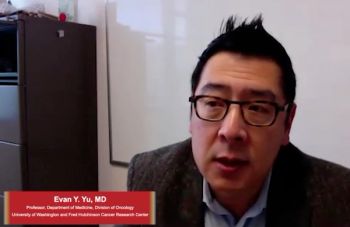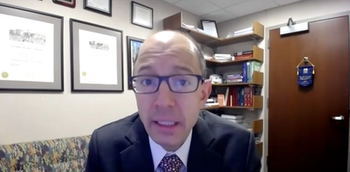
The book incorporates insights from 45 experts across 18 specialties.

The book incorporates insights from 45 experts across 18 specialties.

A search of a legal database found 42 cases related to cystectomy over a 30-year period.

Yu discusses the background of PSMA-PET imaging, current and emerging PSMA imaging tools/therapeutics, and the future of the novel technique in prostate cancer.

“The role of genomic testing in bladder is expanding almost every year,” says Faltas.

In the phase 2 SWOG 1500 study, cabozantinib (Cabometyx) significantly improved progression-free survival versus sunitinib (Sutent) in patients with metastatic papillary renal cell carcinoma.

“Very, very few patients actually had any counseling documented or any medications ordered that would help with smoking cessation,” says Richard S. Matulewicz, MD.

Treatment following progression on chemotherapy and an immune checkpoint inhibitor remains an unmet medical need.

Shaakir Hasan, DO, discusses socioeconomic characteristics associated with the diagnosis and management of bladder cancer.

O’Leary discusses safety related to instillation of the Penuma penile enhancement implant.

Darolutamide is currently approved for the treatment of patients with nonmetastatic castration-resistant prostate cancer.

The immunotherapy/TKI combination significantly improved overall survival versus sunitinib.

“I find [the Prolaris test] to be a very helpful clinical tool,” says Jonathan D. Tward, MD, PhD.

Hear from key opinion leaders in the urology space as they discuss 2 complex cases across the multidisciplinary approach for an incidentally discovered adrenal mass and localized, high-risk prostate cancer with oligometastasis at diagnosis.



“The available information [on] male infertility websites right now is not of good quality,” Samplaski says.

Boorjian anticipates research with nadofaragene firadenovec in settings beyond BCG-unresponsive non-muscle invasive bladder cancer.

O’Leary is 1 of 10 surgeons in the United States capable of performing the surgery to install the FDA-cleared Penuma penile enhancement implant.

Motzer highlights the overall survival benefit achieved with the combination of the PD-1 inhibitor and the multikinase inhibitor versus standard sunitinib in the phase 3 CLEAR trial.

“The biggest risk that our patients face is a severe COVID-19 episode,” says Kutikov.

“One of the things that distinguishes this treatment is its patient and provider ease of delivery,” says Boorjian.

The ongoing trial is enrolling patients at 62 locations in the United States and worldwide.

The FDA recently approved a less-frequent, fixed dose of durvalumab at 1500 mg every 4 weeks for use in patients with metastatic urothelial carcinoma.

The FDA approved darolutamide in July 2019 for the treatment of patients with nonmetastatic castration-resistant prostate cancer, based on findings from the phase 3 ARAMIS trial.

In this interview, Emmanuel S. Antonarakis, MD, provides an overview of rucaparib (Rubraca) and olaparib (Lynparza), discusses the key trials that led to their approvals, and explains the urologist’s role in their use.

“We continue to see a building story of benefit of statin medications in men who have prostate cancer,” says Robert J. Hamilton, MD, MPH.

Williams discusses a study comparing costs for radical versus partial cystectomy.

Chris Du, MD, discusses findings from a study published in Neurourology and Urodynamics.

Investigators evaluated uropathogen prevalence and antibiotic resistance in a urogynecologic patient population.

Attorney Kenton H. Steele, Esq, discusses his recent Urology Times® column.